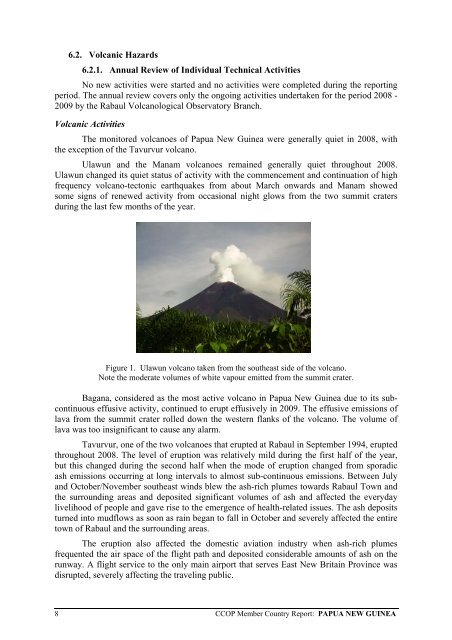Member Country Report of Papua New Guinea - CCOP
Member Country Report of Papua New Guinea - CCOP
Member Country Report of Papua New Guinea - CCOP
You also want an ePaper? Increase the reach of your titles
YUMPU automatically turns print PDFs into web optimized ePapers that Google loves.
6.2. Volcanic Hazards6.2.1. Annual Review <strong>of</strong> Individual Technical ActivitiesNo new activities were started and no activities were completed during the reportingperiod. The annual review covers only the ongoing activities undertaken for the period 2008 -2009 by the Rabaul Volcanological Observatory Branch.Volcanic ActivitiesThe monitored volcanoes <strong>of</strong> <strong>Papua</strong> <strong>New</strong> <strong>Guinea</strong> were generally quiet in 2008, withthe exception <strong>of</strong> the Tavurvur volcano.Ulawun and the Manam volcanoes remained generally quiet throughout 2008.Ulawun changed its quiet status <strong>of</strong> activity with the commencement and continuation <strong>of</strong> highfrequency volcano-tectonic earthquakes from about March onwards and Manam showedsome signs <strong>of</strong> renewed activity from occasional night glows from the two summit cratersduring the last few months <strong>of</strong> the year.Figure 1. Ulawun volcano taken from the southeast side <strong>of</strong> the volcano.Note the moderate volumes <strong>of</strong> white vapour emitted from the summit crater.Bagana, considered as the most active volcano in <strong>Papua</strong> <strong>New</strong> <strong>Guinea</strong> due to its subcontinuouseffusive activity, continued to erupt effusively in 2009. The effusive emissions <strong>of</strong>lava from the summit crater rolled down the western flanks <strong>of</strong> the volcano. The volume <strong>of</strong>lava was too insignificant to cause any alarm.Tavurvur, one <strong>of</strong> the two volcanoes that erupted at Rabaul in September 1994, eruptedthroughout 2008. The level <strong>of</strong> eruption was relatively mild during the first half <strong>of</strong> the year,but this changed during the second half when the mode <strong>of</strong> eruption changed from sporadicash emissions occurring at long intervals to almost sub-continuous emissions. Between Julyand October/November southeast winds blew the ash-rich plumes towards Rabaul Town andthe surrounding areas and deposited significant volumes <strong>of</strong> ash and affected the everydaylivelihood <strong>of</strong> people and gave rise to the emergence <strong>of</strong> health-related issues. The ash depositsturned into mudflows as soon as rain began to fall in October and severely affected the entiretown <strong>of</strong> Rabaul and the surrounding areas.The eruption also affected the domestic aviation industry when ash-rich plumesfrequented the air space <strong>of</strong> the flight path and deposited considerable amounts <strong>of</strong> ash on therunway. A flight service to the only main airport that serves East <strong>New</strong> Britain Province wasdisrupted, severely affecting the traveling public.8 <strong>CCOP</strong> <strong>Member</strong> <strong>Country</strong> <strong>Report</strong>: PAPUA NEW GUINEA
















